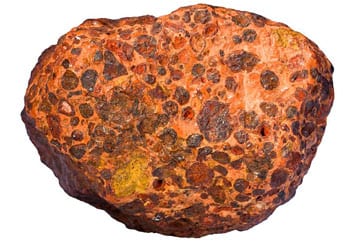Zabi Harshe:
Aluminum ne ya fi kowa karfe kashi samu a Duniya, totaling about 8% na Duniya ta ɓawon burodi. Duk da haka, aluminum as an element is reactive and therefore does not occur naturally – it needs to be refined to produce aluminum metal. A farko farawa abu don aluminum refining ne haƙar, duniya main kasuwanci tushen aluminum. Bauxite is a sedimentary rock, and consists mostly of the aluminium minerals gibbsite (Al(OH)3), boehmite (c-Alo(OH)) kuma diaspore (a-Alo(OH)), and is usually mixed with the two iron oxides goethite and hematite, the aluminium clay mineral kaolinite and small amounts of anatase (TiO2) and/or ilmenite (FeTiO3).

Haƙar adibas ne baza a dukan duniya, mafi yawa abin da ke faruwa a wurare masu zafi ko subtropical yankuna. Although proven reserves of bauxite are expected to last for many years, ingancin da reserves cewa za a iya tattalin arziki isa aka ragewa. domin refiners, who are in the business of bauxite processing to make alumina, kuma ƙarshe aluminum karfe, wannan shi ne wani kalubale da duka kudi da kuma muhalli da abubuwan.
The process to refine metallurgical bauxite into alumina involves the following inputs:
The following outputs are generated:

The most widely used chemical process of refining bauxite into alumina, tsarin aikin Bayer, involves dissolving the Al2O3 out of the bauxite rock with caustic soda (NaOH) at elevated temperature and pressure. The Al2O3 fraction of the bauxite is dissolved into solution, to later be precipitated out as alumina. Duk da haka, a high-grade bauxite contains up to 60% Al2O3, and many operating bauxite deposits are well below this, lokaci-lokaci kamar yadda low kamar yadda 30-40% Al2O3. Because the desired product is a high purity Al2O3, sauran oxides a haƙar (Fe2O3, SiO2, TiO2, Organic material) are separated from the Al2O3 and rejected as alumina refinery resides (arr) or red mud. a general, ƙananan ingancin haƙar (ie lower Al2O3 content) the more red mud is generated per ton of alumina product. Bugu da kari, even some Al2O3 bearing minerals, musamman irin kaolinite, produce un-desirable side reactions during the refining process and lead to an increase in red mud generation, kazalika da asarar tsada caustic soda sinadaran, a manyan m kudin a haƙar refining tsari.
Red laka ko arr wakiltar babban kuma a kan-faruwa kalubale ga aluminum masana'antu. Red laka ƙunshi gagarumin saura caustic sinadaran ragaggen daga refining tsari, kuma shi ne sosai alkaline, sau da yawa tare da PH na 10 - 13. It is generated in large volumes worldwide – according to the USGS, kiyasta duniya alumina samarwa ya 121 ton miliyan a 2016. This likely resulted in more than 150 ton miliyan na ja laka generated lokacin daidai wannan lokacin. Duk da gudana bincike, ja laka a halin yanzu yana da 'yan kudi ne mai yiwuwa hanyoyi don amfani sake amfani. An kiyasta cewa, sosai kadan na ja laka ne beneficially sake amfani a duniya. Instead the red mud is pumped from the alumina refinery into storage impoundments or landfills, inda aka adana da kuma kula a manyan kudin.
A asarar tsada caustic soda (NaOH) and the generation of red mud are both related to the quality of the bauxite used in the refining process. a general, the lower the Al2O3 content of the bauxite, da ya fi girma da girma na ja laka cewa za a generated, as the non-Al2O3 phases are rejected as red mud. Bugu da kari, the higher the kaolinite or reactive silica content of the bauxite, da mafi ja laka za a generated. The reactive silica content not only increases the volume of red mud, but also consumes caustic soda reagent and reduces the yield of Al2O3 recovered from the bauxite. Saboda haka, there is both an economic and environmental argument to be made for improving the quality of bauxite prior to refining.
A STET bushe rabuwa aiwatar tayi haƙar kera ko haƙar refiners wata damar yin pre-Bayer-aiwatar da haɓaka na haƙar tama don inganta ingancin. Wannan dabarar yana da yawa amfanin:
a takaice, bushe aiki tare da STET SEPARATOR tayi damar don samar da darajar for haƙar kera da kuma refiners. A pre-aiki na haƙar kafin refining zai rage sinadaran halin kaka, runtse da girma na ja laka generated da kuma rage aiwatar kofi.
References: